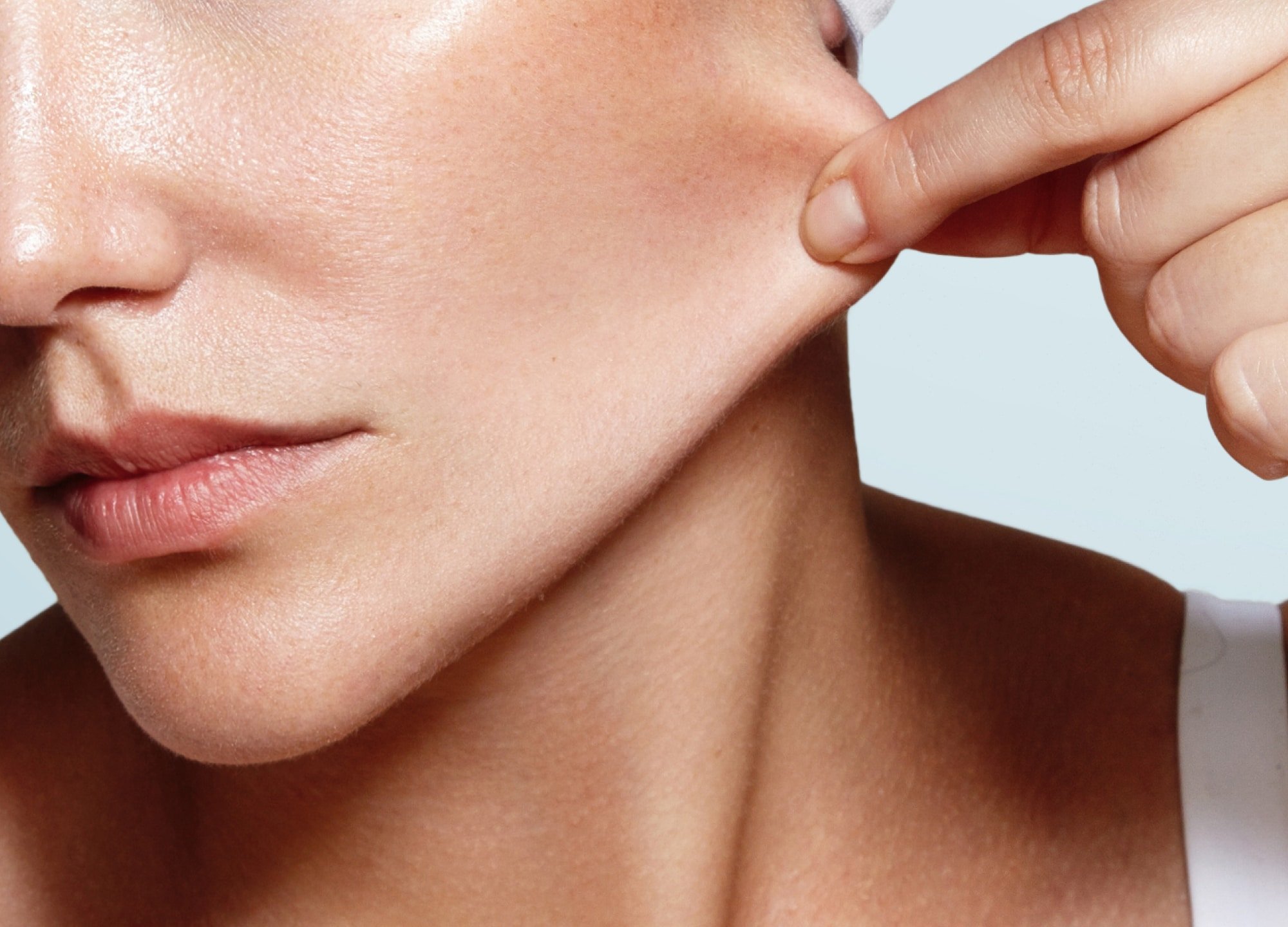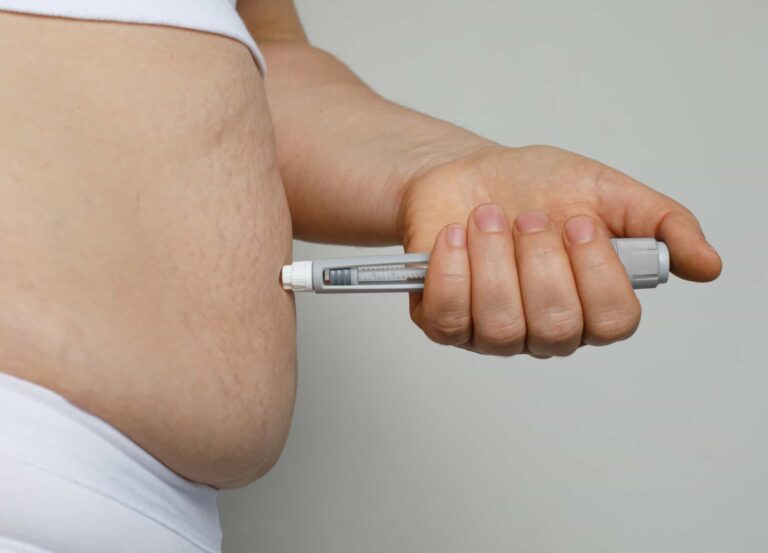The Ozempic hype you’ve been reading and hearing about is real. Also known by the brand name Wegovy and generic semaglutide, it’s being hailed as a “miracle drug” for weight loss worldwide, with plenty of patients paying thousands of dollars out of pocket to reap the rewards of the diabetes drug. But it’s only recently that the conversation around semaglutide has turned to the aftereffects, which some people on social media are pithily referring to as “Ozempic face.” This term is speaking to the gaunt or sunken look that can be caused by a loss of facial fat. Others still are talking about skin laxity and even hair loss.
But here’s the thing: any significant weight loss, regardless of how it’s achieved, is going to result in physical changes. For example, think about how pregnancy affects the body. “After delivering a baby, the belly will look deflated and saggy, but the skin eventually catches up and tightens,” explains Dr. Jessie Cheung, a board-certified dermatologist in Chicago who specializes in aesthetics, regenerative medicine, and hormone replacement therapy. “How well and how quickly that happens depends on the amount of weight loss, the speed of the weight loss, and the overall health of the skin—older skin won’t contract as well.” And because fat loss from Ozempic occurs from head to toe, it won’t be only the face that’s affected.
Keep in mind though that all patients using the GLP-1 medication are on their own journeys; while the medication is approved by the Food and Drug Administration (FDA) to treat obesity and type 2 diabetes, it’s also being used off-label by patients who, comparatively, may not have so much weight to lose. “Weight loss induced by injections of semaglutide, though shown to be quite effective, is typically not terribly extreme,” says Dr. Evan Garfein, a board-certified plastic surgeon in New York City. Because semaglutide’s mechanism of action is related to appetite suppression, weight loss from the drug alone is not as extreme as it might be when paired with bariatric surgery like endoscopic sleeve gastroplasty. How much your appearance changes after taking the medication for weight management will depend entirely on your unique situation.
Just like mommy makeovers have become popular postpartum procedures, so too will treatments that help address the aesthetic side effects that Ozempic-induced weight loss has left in its wake. Whether you’ve lost a large amount of your body weight or some pandemic pounds that have been bugging you, we’ve outlined post-Ozempic treatment options that will address concerns from head to toe.
Treatments for Ozempic-related hair loss
Undoubtedly, the fear of experiencing hair loss from taking semaglutide is enough to give a would-be patient pause. This is especially true of patients with polycystic ovarian syndrome (PCOS). Not only do individuals with PCOS struggle to lose weight due to insulin resistance, but the hormonal imbalances of this condition cause many to experience hair loss (while often struggling with hirsutism, or excess body hair). However, generally speaking, hair loss induced by the weight loss drug isn’t permanent. “Any metabolic stress can lead to temporary hair loss, also known as telogen effluvium,” explains Dr. Cheung. “This sudden increase in the shedding of dead hairs is self-limiting, usually lasting for a few months.”
That said, it’s critical that you work with your provider to ensure you’re getting enough nutrients into your diet to support new hair growth. “We know that optimal levels of vitamin D, B, iron, zinc, thyroid, and other hormones are important for hair metabolism, as is adequate protein intake,” Dr. Cheung says. Your provider can make recommendations tailored to your exact needs regarding over-the-counter and prescription wellness supplements as well as aesthetic treatments.
For example, low-level laser therapy promotes hair growth without downtime. You can get stronger, in-office treatments or opt for at-home treatment with a device like Current Body’s CapillusUltra Laser Cap ($799). Another well-known pro treatment is platelet-rich plasma, or PRP, for hair loss. “The procedure involves taking a sample of the patient’s blood and spinning it in a centrifuge, separating their own natural growth factors and biostimulators,” explains Dr. David Shafer, a board-certified plastic surgeon in New York City. “The solution is then injected into the scalp for hair growth . . . it can help boost thinning hair and also stimulate dormant follicles.”
Dr. Cheung’s preferred treatment for hair growth is exosome therapy. “Exosomes are vesicles secreted by stem cells, containing hundreds more growth factors than PRP and with more anti-inflammatory properties,” she says. “They can be applied topically after microneedling or lasering the scalp, and there are ongoing studies with injections.” New growth can often be seen within a few weeks, with many patients being happy with their results after just one treatment.
Treatments for “Ozempic face”
“Ozempic face” is not necessarily as simple as restoring volume. Depending on the amount of weight the patient has lost and the elasticity of their skin, the results of semaglutide treatment can seemingly accelerate the facial aging process by causing superficial and deep fat pads to shrink while making the overlying tissues appear saggy. The good news? The same procedures that can treat signs of aging, such as volume loss, loss of fat, collagen production decline, and sagging skin, can help rectify the less-than-satisfactory outcomes that can be caused by weight loss medications.
“We are lucky to live in a time that offers patients a wide variety of treatments for aesthetic concerns,” says Dr. Garfein. “The key for people wishing to treat the resultant facial skin and soft tissue laxity is to go to someone who can tailor a solution to their specific needs.” Because there are many layers to consider, including the skin, fat, and deeper tissues, it is critical to get a provider’s take on how best to treat your face—if what you’d really benefit from is a facelift, a skin-tightening treatment that offers zero downtime won’t cut it.
In some cases though, mild to moderate laxity can be sufficiently treated with noninvasive or minimally invasive procedures. Dr. Garfein points to radiofrequency and ultrasound treatments like Morpheus8, Potenza, and Ultherapy as effective options for tightening things up, while Dr. Cheung likes PDO threads for lifting and contouring. Biostimulatory fillers can help here too while restoring lost volume. “Sculptra is great for temples, and Radiesse is excellent for the backs of the hands,” says Dr. Shafer.
Traditional hyaluronic acid dermal fillers like those from Juvéderm—Voluma for cheeks, Volux for jawline, and Vollure, which Dr. Shafer likes to use under the eyes—are straightforward treatments for adding fullness back to a gaunt face. However, Dr. Garfein prefers a more natural approach. “I am a big fan of fat grafting for focal augmentation of the face,” he says. “There is no data to suggest that fat grafting is less effective in patients who have taken semaglutide to lose weight.” (Potential bonus: when undergoing liposuction for your transfer, you can harvest it from an area with stubborn fat.) “The trade-offs between injecting autologous fat for elevation of the malar region, with or without a facelift, depend on the surgeon’s comfort and the patient’s preferences,” he adds. Remember, you can’t really fake the results of plastic surgery with less invasive procedures, so take your provider’s recommendations to heart.
Treatments for Ozempic-related body concerns
If you’ve experienced extreme and/or rapid weight loss from Ozempic and notice excess skin or severe sagging on the body, only surgical procedures will do. “Patients may require abdominoplasty, to remove excess abdominal skin, thigh lift, to tighten the skin on their legs, and brachioplasty, to tighten their arms,” says Dr. Shafer, just to name a few. “Often, we do a combination of noninvasive and surgical treatments to achieve the best results.” He likes treating patients with Renuvion, a plasma energy treatment, in the operating room, to help further tighten loose skin.
When undergoing surgery, keep in mind that you’ll want to hit your goal weight and maintain it for a few months. “If the patient loses more weight after the procedure, we will not have gotten optimal results—and the same is true if the patient regains weight in the weeks and months after treatment,” says Dr. Garfein. “Having the patient maintain a goal weight for a little while reduces this likelihood.” That’s not the case if you’re relying on nonsurgical procedures to help tighten up though. “For noninvasive treatments, the sessions can start as soon as the patient is ready,” says Dr. Shafer. “Effects are cumulative and can even start working while the patient is continuing to lose weight.”
Beyond Ultherapy and other energy-based skin-tightening treatments, muscle toning is a nice complement to weight loss. “Muscle toning is great for how patients look and feel and also has benefits for the cardiovascular and musculoskeletal systems,” says Dr. Garfein. Weight training is key—working out in this way helps preserve muscle mass, and muscles burn calories during and after a workout. However, if you’ve taken semaglutide, you know that you might not always feel like exercising, due to fatigue. Though it won’t offer the same benefits as a gym session, the muscle-toning and fat-burning treatment Emsculpt Neo, which can be combined with cellulite-smoothing Emtone, can be a nice option.











